MARIANI’S
Virtual
Gourmet
February 21,
2016
NEWSLETTER
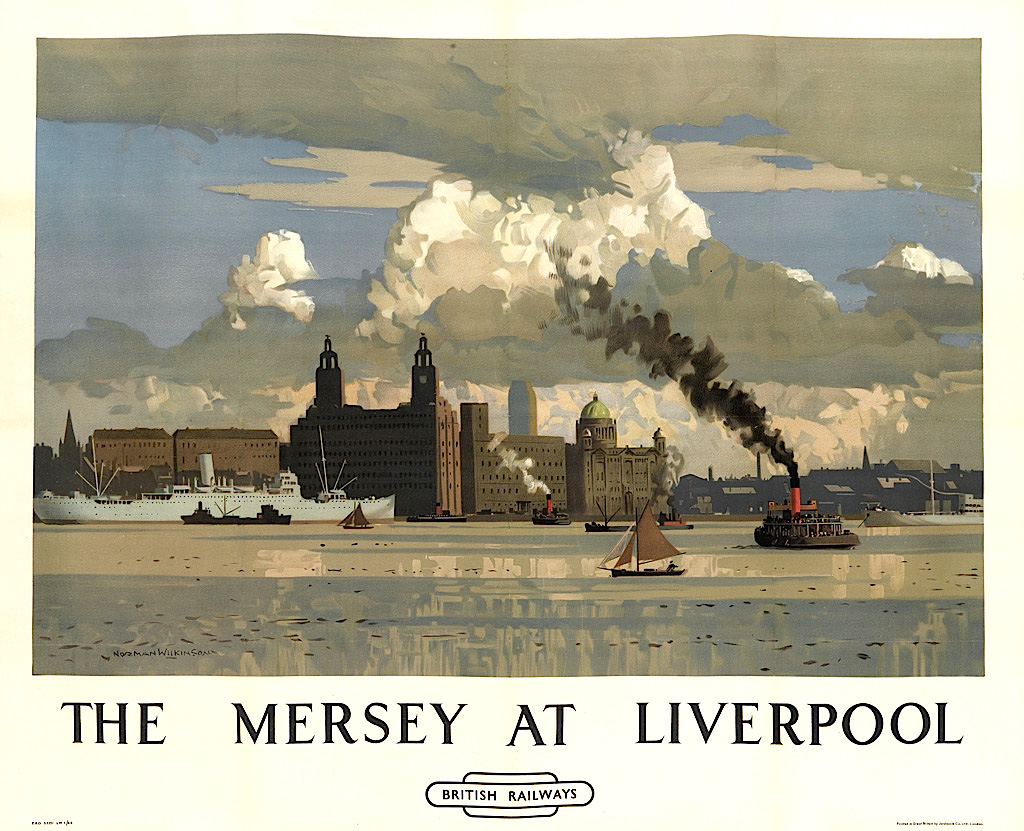
Ad for
British Railways (1948) by Norman Wilkinson
IN THIS ISSUE
DINING IN DUBAI
By John Mariani
NEW YORK CORNER
CHEVALIER
By John Mariani
NOTES FROM THE WINE CELLAR
WHAT I'M DRINKING NOW
By John Mariani
❖❖❖
DINING IN DUBAI
By John Mariani
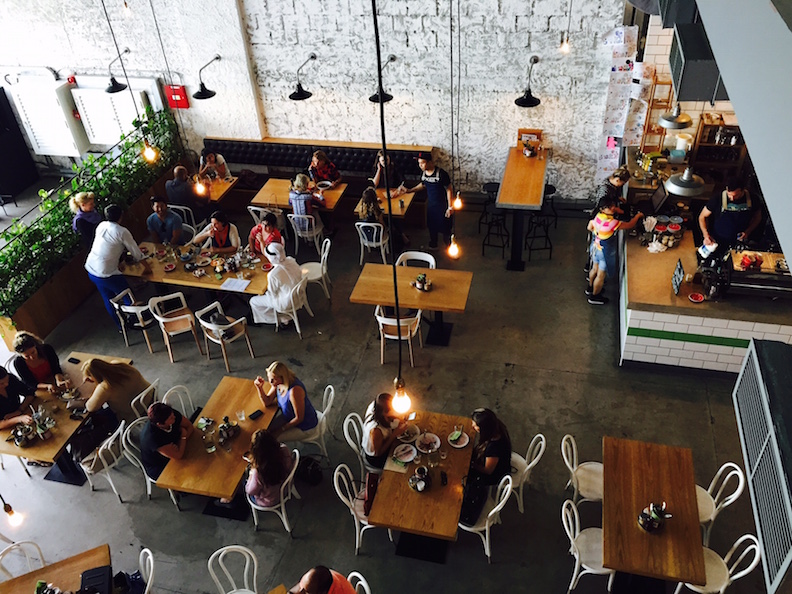
Tom & Serg restaurant
I am probably not the first to suggest
that Dubai’s model for restaurants is Las Vegas,
not least in the way they scoop up name chefs and
fashion people in management contracts to give
them immediate cachet. Which doesn’t mean they are
mere copies of the originals. Indeed,
when I visited Dubai I was struck by the quality
of the ingredients as much as by the elegant
design of the restaurants and variety of cuisine
prepared.
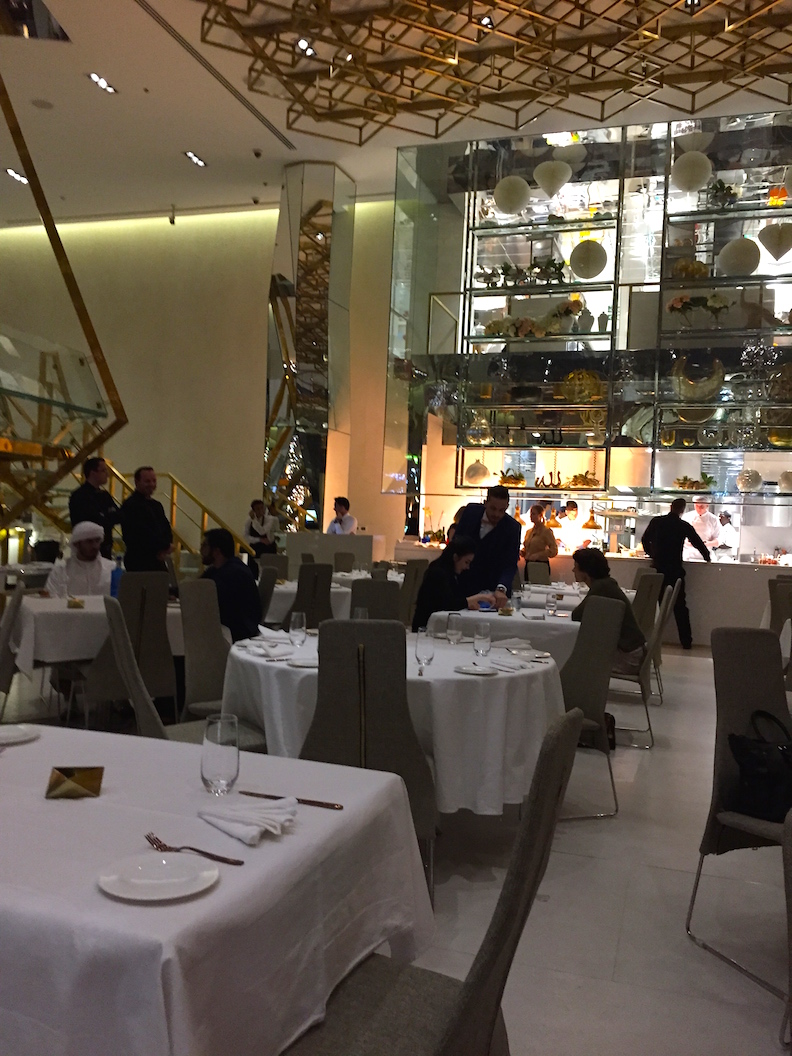 Almost all
ingredients need to be shipped in, for there is
little farming in the small Emirate: one chef told
me that when they first opened the restaurant, 75%
of the ingredients were frozen. But the hotel
owners apparently spare nothing to allow chefs to
order what they want and according to what kind of
menus they have back home, including restaurants
like Zuma
and The Ivy,
both out of London, Reflets by
Paris’s Pierre Gagnaire, who’s also in Las Vegas, and Nobu.
(Wolfgang Puck had a CUT Steakhouse
at The Address Hotel, but, as you must have read,
that hotel had a major fire in December and has yet
to re-open.)
Almost all
ingredients need to be shipped in, for there is
little farming in the small Emirate: one chef told
me that when they first opened the restaurant, 75%
of the ingredients were frozen. But the hotel
owners apparently spare nothing to allow chefs to
order what they want and according to what kind of
menus they have back home, including restaurants
like Zuma
and The Ivy,
both out of London, Reflets by
Paris’s Pierre Gagnaire, who’s also in Las Vegas, and Nobu.
(Wolfgang Puck had a CUT Steakhouse
at The Address Hotel, but, as you must have read,
that hotel had a major fire in December and has yet
to re-open.)
Before I describe some of the
restaurants I dined at, one caveat should be stated
right away: Under Islamic law, alcohol--not even
beer--may not be served in any restaurant outside of
a hotel, which is a major drawback for any
free-standing restaurant, and there’s no B.Y.O.B. And I
swear, it is not a little off-putting to eat at a
fine restaurant and have to drink fruit smoothies
with your meal.
This is
nowhere more disappointing than in one of the best
and most popular new restaurants to open downtown, Omnia by Silvena (left), which
takes its name from the ever-ebullient chef-owner
Silvena Rowe, well known for her restaurants,
cookbooks and TV shows in London. Located
right on Sheik Mohammed Bin Rashid Boulevard, the
glass-fronted two-story restaurant is a dazzler,
rife with color, mirrors and a wall of
calligraphy-graffiti.
Rowe, who is part Bulgarian and
part Turkish, has been smart to feature her own
versions of modern Middle Eastern cuisine, with
ingredients sourced from outside the country,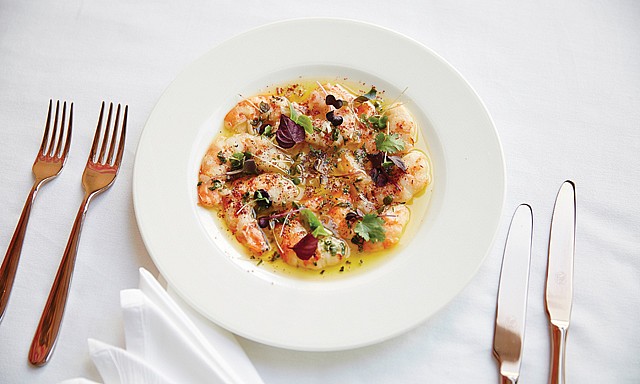 even to farm-raised shark from the
UAE, served with crispy golden gasheed croquettes
and smoked shark cubes (59Dh; 3.67Dh = $1). Gulf
prawns come with a wonderfully creamy, well-seasoned
hummus, topped with fragrant sumac and hot chili (49
Dh).
even to farm-raised shark from the
UAE, served with crispy golden gasheed croquettes
and smoked shark cubes (59Dh; 3.67Dh = $1). Gulf
prawns come with a wonderfully creamy, well-seasoned
hummus, topped with fragrant sumac and hot chili (49
Dh).
Fresh foie gras from Hungary is
served in a form of crème brûlée with caramelized
dates (79Dh), while an Ottoman-style kofta is
made from ground wagyu beef oozing kashkaval
cheese. There
are also vegetarian and gluten-free items on the
lavish menu, and with it all you have your choice of
more than a dozen fruit smoothies or non-alcoholic
cocktails. Desserts
are fanciful, like the chocolate sphere encased in
edible 24k gold at a whopping 79Dh.
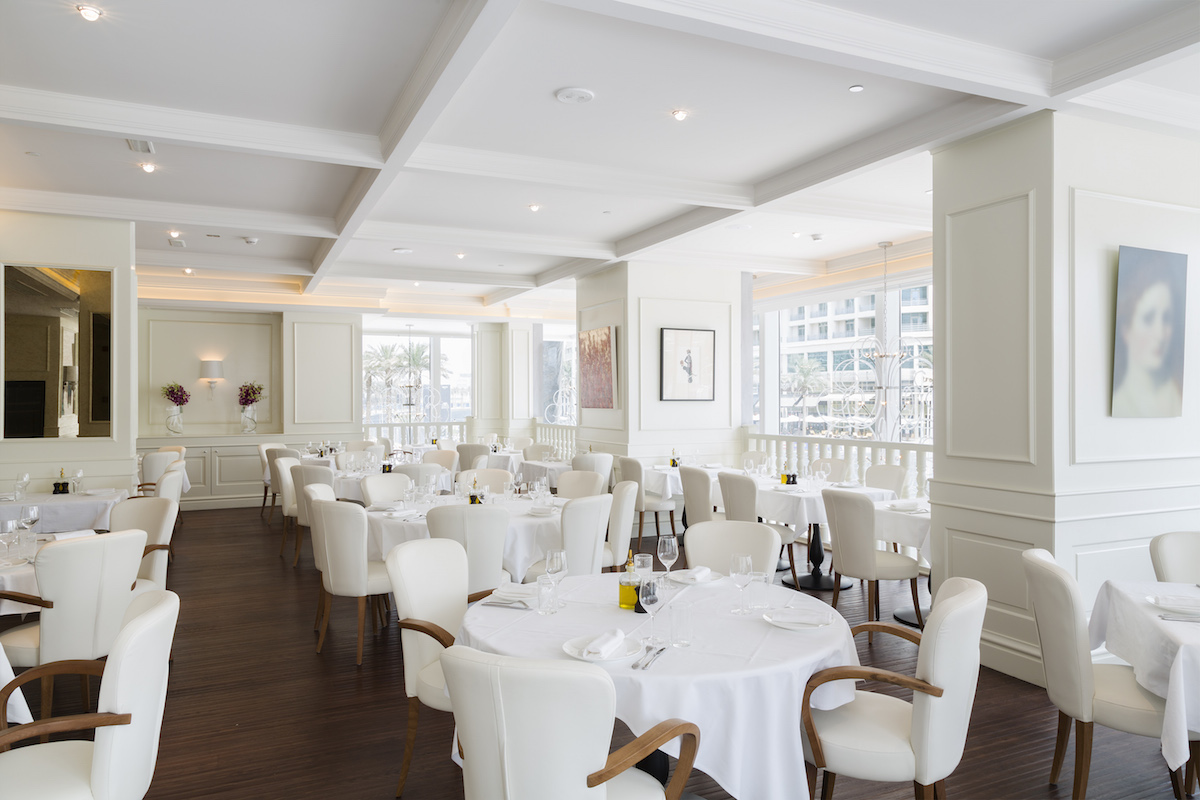 La Serre
(left), in
the Vida
Downtown Dubai Hotel, is set on two stories, as both
a bistro and boulangerie under Executive Chef Izu
Ani (below),
who is well schooled in classic French culinary
traditions. Many
people come here for the extensive breakfasts—you
can sit at the open kitchen counter--but La Serre is
most fun for a sun-filled lunch overlooking the
Boulevard. Starched tablecloths and a
cream-and-white color scheme, with wraparound
windows, give a palpable cheeriness to the ambiance,
where you may begin with
La Serre
(left), in
the Vida
Downtown Dubai Hotel, is set on two stories, as both
a bistro and boulangerie under Executive Chef Izu
Ani (below),
who is well schooled in classic French culinary
traditions. Many
people come here for the extensive breakfasts—you
can sit at the open kitchen counter--but La Serre is
most fun for a sun-filled lunch overlooking the
Boulevard. Starched tablecloths and a
cream-and-white color scheme, with wraparound
windows, give a palpable cheeriness to the ambiance,
where you may begin with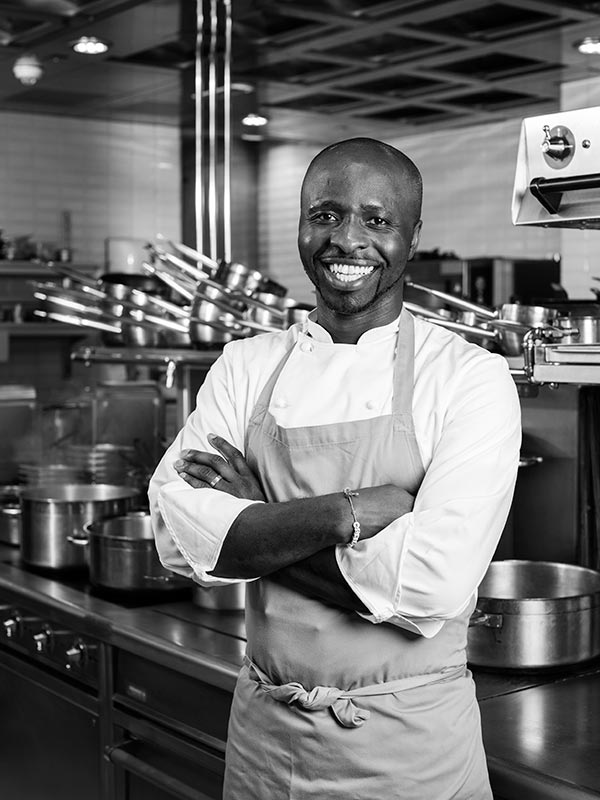 a lovely dish of
Cornish crab (95Dh), or lobster salad with asparagus
(145Dh), or a textbook-perfect onion tart (45Dh).
a lovely dish of
Cornish crab (95Dh), or lobster salad with asparagus
(145Dh), or a textbook-perfect onion tart (45Dh).
Thinly sliced raw scallops are
marinated in sumac and lime (110Dh), and there
is a lustrous yellowtail tuna carpaccio (75Dh).
There are at least seven seafood dishes for main
courses, including whole baked bream with Provençal
spices (215Dh), but the lamb dishes are stand-outs
here, like lamb chops marinated in Eastern spices
(185Dh), or with apricots (195Dh). For
dessert, the apple tarte Tatin
(for four) on a buttery, caramelized crust is as
fine as I’ve had in Southern France (65Dh), and
there’s nothing to criticize about the rich, crispy
sugar-topped crème brûlée (60Dh).
The wine selection is quite good,
if expensive.
My first meal in Dubai was as
restorative as if I had just landed in Nice and went
off to a favorite bistro. 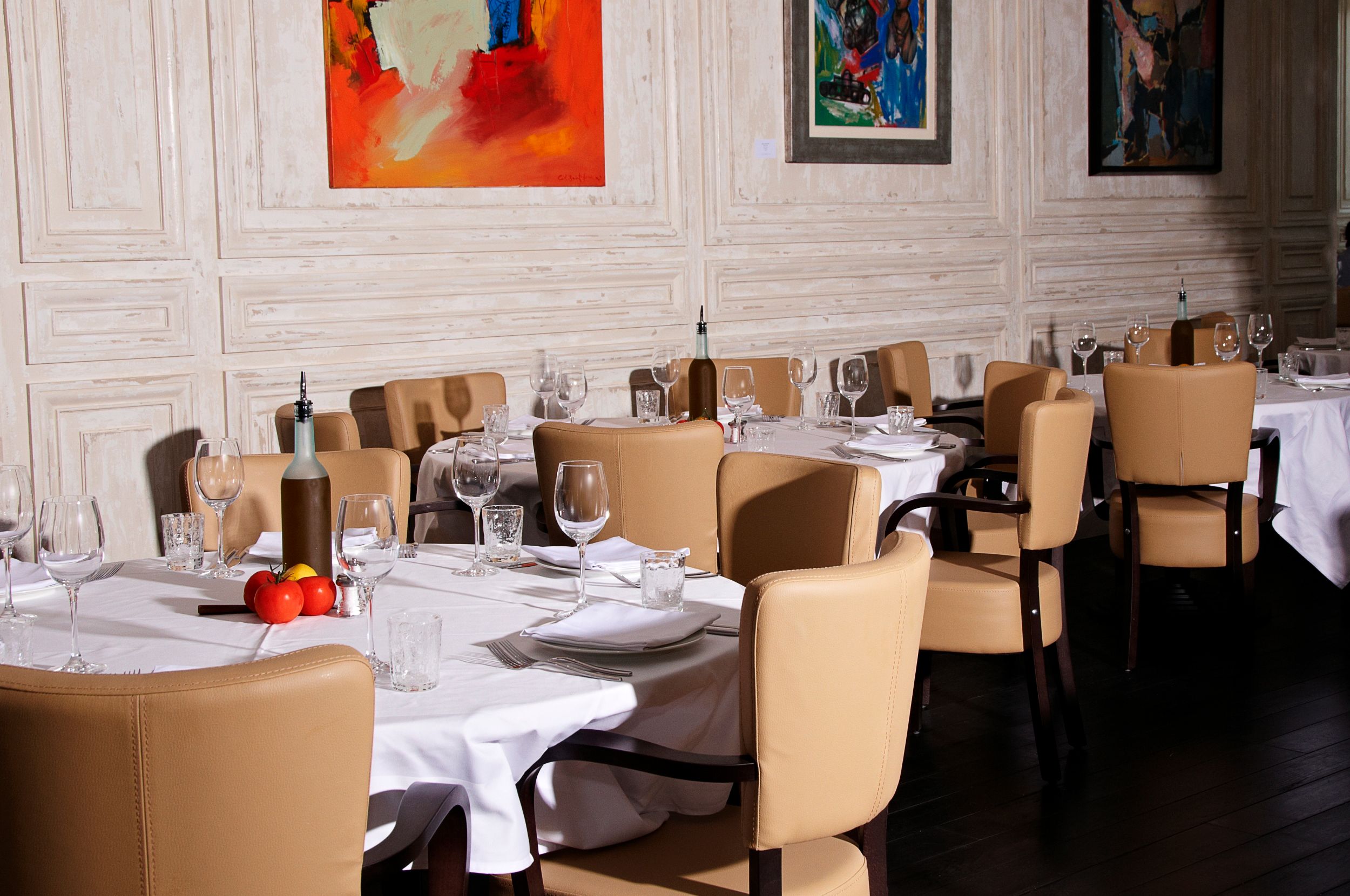 I dined with
some new friends in an engaging spot with a
well-dressed international clientele—La Petite
Maison (left),
which has branches in London, Istanbul and Mumbai. The food
here is from the French and Italian Rivieras, with
ample use of aromatic olive oil in its dishes. The wine
list is very extensive, with two dozen Champagnes
(several by the glass) and
I dined with
some new friends in an engaging spot with a
well-dressed international clientele—La Petite
Maison (left),
which has branches in London, Istanbul and Mumbai. The food
here is from the French and Italian Rivieras, with
ample use of aromatic olive oil in its dishes. The wine
list is very extensive, with two dozen Champagnes
(several by the glass) and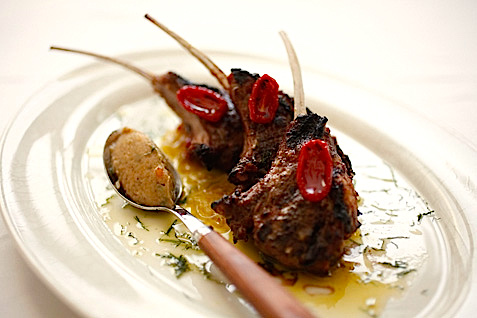 an
admirable number of rosés from Provence.
an
admirable number of rosés from Provence.
The staff is multilingual, with a good number
of French and Italian cooks and staff behind the
stoves and in the dining room.
I was duly impressed with tender
snails Burgundy-style in garlic butter (95Dh) and a
light crab and lobster salad (110Dh), and all
the classics are here, from sea bream baked en papillôte
(195Dh) and creamy risotto with black truffles
(280Dh) to grilled cutlets of lamb (right) with
smoked eggplant (175Dh) and a confit of rabbit leg
with grilled artichokes (185Dh).
Desserts were truly outstanding,
from a warm chocolate mousse with malt ice cream
(60Dh) to a nicely egg-rich pain perdu
with spice ice cream (50Dh). The bar
scene here is both swank and sexy when the desert
sun goes down.
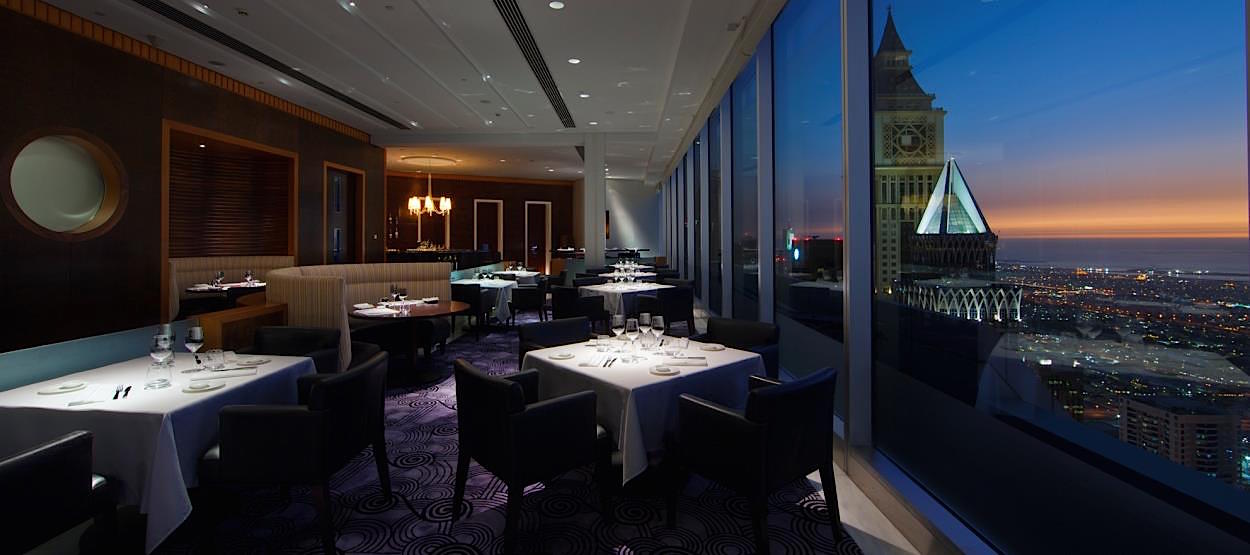 Of
course, Dubai has the requisite high-end Italian
restaurants, including one of the branches of very
popular Serafina,
and Alta
Badia e Mangia (left) on Jumeirah Emirates Towers'
50th floor, is justly considered one of the finest,
under Chef Claudio Melis, who specializes in
northern Italian cuisine like housemade tagliatelle
with funghi
porcini and Norcia black truffles (98Dh) and vitello tonnato
(85Dh) from Piedmont.
Ravioli are packed with braised oxtail and
Norcia truffles (110Dh) and lamb shoulder is slowly
braised for succulence, served with a potato terrine
and baby vegetable dusted with thyme (165Dh). The
restaurant has a superb list of Italian wines that
go so well with this very authentic cooking. The
dining room, stylishly decorated, is very
romantic at night in its soft colors and its view of
the city. There is a very good 310Dh tasting
menu of five courses, with specialties from the
Italian Dolomites.
Of
course, Dubai has the requisite high-end Italian
restaurants, including one of the branches of very
popular Serafina,
and Alta
Badia e Mangia (left) on Jumeirah Emirates Towers'
50th floor, is justly considered one of the finest,
under Chef Claudio Melis, who specializes in
northern Italian cuisine like housemade tagliatelle
with funghi
porcini and Norcia black truffles (98Dh) and vitello tonnato
(85Dh) from Piedmont.
Ravioli are packed with braised oxtail and
Norcia truffles (110Dh) and lamb shoulder is slowly
braised for succulence, served with a potato terrine
and baby vegetable dusted with thyme (165Dh). The
restaurant has a superb list of Italian wines that
go so well with this very authentic cooking. The
dining room, stylishly decorated, is very
romantic at night in its soft colors and its view of
the city. There is a very good 310Dh tasting
menu of five courses, with specialties from the
Italian Dolomites.
If you seek out
modern Dubai cuisine, Qbara (below) has a
breadth and depth difficult to find elsewhere. It’s a
huge restaurant on two levels and the nightclub
element looms large after nine p.m. The
extraordinary, shadowy décor is full of carved timber motifs bathed in a
golden glow of light. Best thing to
do is to sit down at a big table with several
friends and order family style, to be rewarded with
tantalizing ceramic casseroles and plates piled with
such offerings as aromatic spiced beef tartare with
tomato and red salsa (80Dh), and crisp soft shell
crab (in season) with garlic and red-hot harissa
powder (85Dh).
Black cod, for two people or more, comes atop
spiced rice with caramelized onions (190Dh), and fat
quail are cooked in grape vines with pistachio labneh
yogurt cheese (90Dh).
Of course, the steaming Arabic breads
selection, with olive oil and a sesame-rich za’atar
dip (35Dh), is wholly addictive with this kind of
food; the potatoes are fried in duck fat (38Dh).The
British chef here when I visited has moved on, but
the menu remains pretty much the same under new head
chef Mohannad.
A very casual
and much sought-out spot among young people in Dubai
is Tom & Serg,
opened five years ago in the Al Quoz industrial area
(look for the Ace Hardware Store) by Tom Arnel, from
Melbourne, and Sergio Lopez, from Madrid, who knew
this was just the kind of big, open, no-frills spot
with global food that the city needed, open for
breakfast and through lunch, so you might sit down
in the morning for salted caramel French toast
(43Dh) or a Cubano sandwich (57Dh) or go later and
scarf up Moroccan chicken with wild rice salad,
feta, rueful and preserved lemon (55Dh).
Salads and vegetable are among the best dishes, and
their ravioli is light, delicate and delicious, with
shavings of Parmigiano. The hot chocolate is made
with Valhrona chocolate and the coffee a house
blend. For dessert go with the orange cheesecake
(22Dh) or the Dubai version of cronuts (25Dh). They call
their place (now one of four) a café, first setting
out to bring good coffee to the city, but it’s a
whole lot more and Chef Arnel is making some of the
most contemporary global food in Dubai right now.
You can’t help but have a good time, and the
people-watching is terrific.
Note: Tipping is uncommon in Dubai restaurants
where service is included in the bill.
❖❖❖
By John Mariani
Photos by van Sung
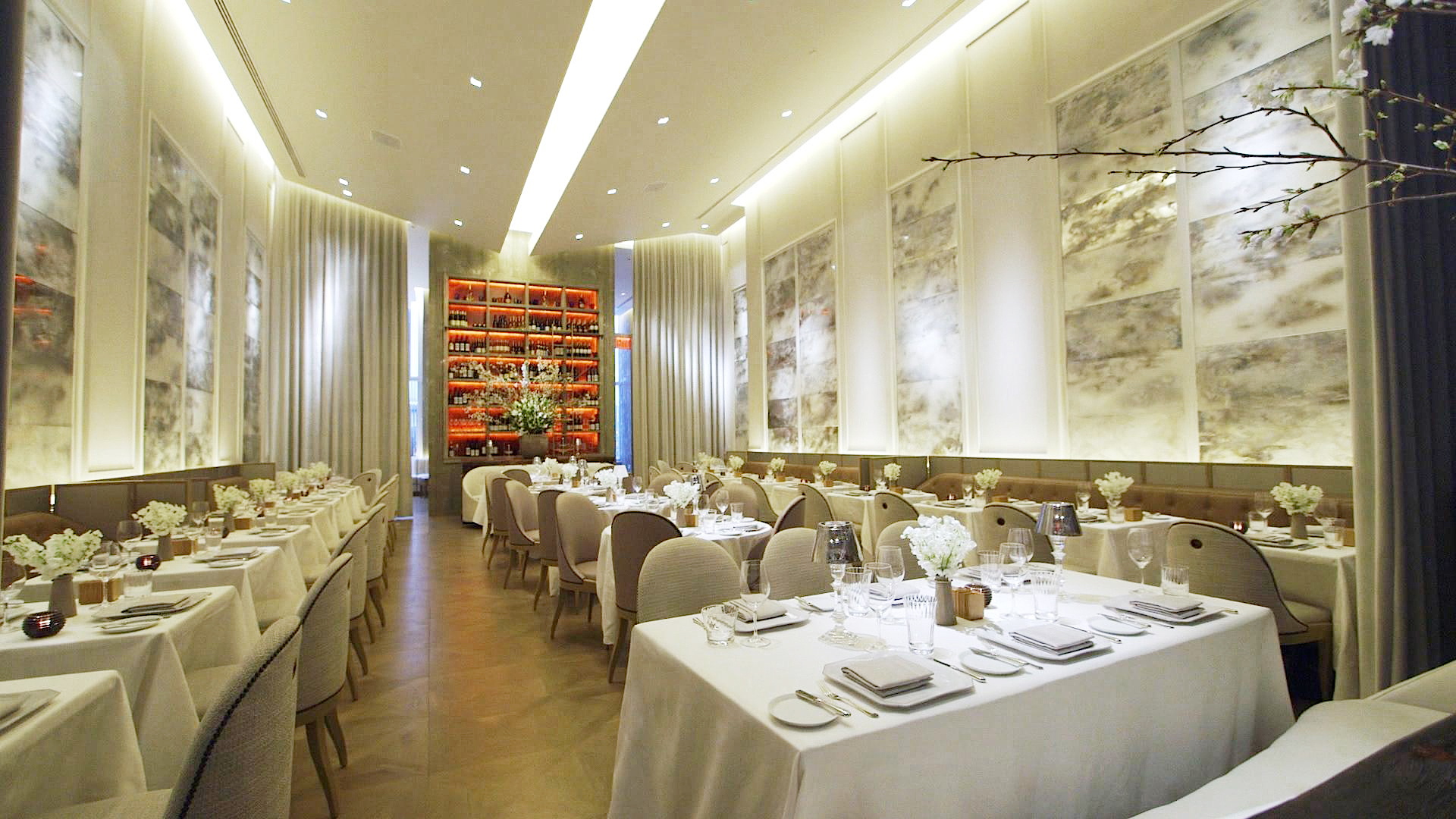
CHEVALIER
Baccarat Hotel
30 W 53rd Street (near Avenue of the Americas)
212-790-8869
baccarathotels.com/dining/chevalier
There
are fresh flowers on every table and a large
spray to the rear of the long dining room. The
linens are soft, the lighting is too. The wait
staff is impeccably dressed. The
noise level in the room is wholly civilized. The
butter is salted just enough and served at the
right temperature. The complimentary hot gougères
puff pastries ooze with a truffled Mornay cream.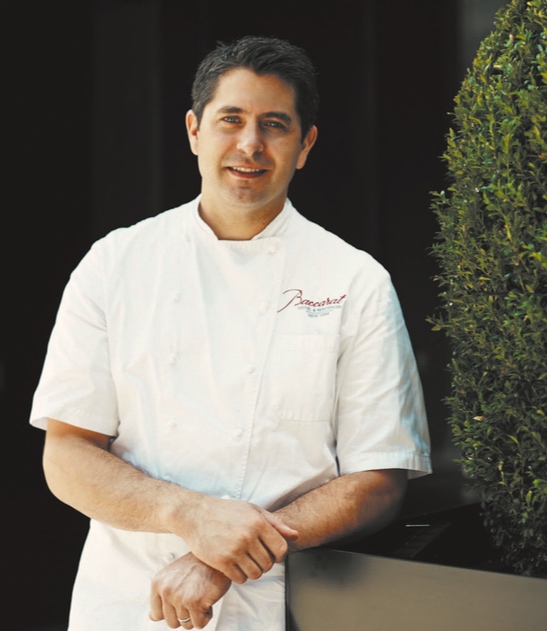
You are at Chevalier, the
ten-month-old fine dining room in the Baccarat
Hotel, just across from MOMA. And
from the first warm greeting by managers Alexandra
Levy and Alessandra Lavey, you sense that the
evening will take as long as you wish in order to
enjoy all of Chevalier’s many pleasures, foremost
Chef Shea Gallante’s cuisine, which epitomizes
what fine dining, without pretension, means in NYC
now.
Chevalier is not
a place where you’ll be presented with six sea
salts or seven knives, nor is it a place where the
clientele all look like they reluctantly drifted
down from their hotel rooms. Indeed,
when I dined there after a rough snowfall the
night before, everyone from tall, slinky Asian
models to young businessmen and women occupied
most of the room, comforted by the banquettes, the
soft carpet and the pearly cast of the walls. The
ceiling is a little too high, perhaps, but the
openness of the room and just the right number of
seats, 70, preceded by an elegant bar, add in
grandeur what it lacks in intimacy.
As NYC’s gossipy food
media sniffed last year, Chevalier was originally
to be managed by Charles Masson, for decades a
partner at La Grénouille, but that arrangement
lasted only a few weeks over disagreements with
management. The assumption was that, without the
Masson name, Chevalier would just lapse into being
a mediocre hotel dining room. Clearly, it
has not.
One NYC restaurant critic
called Chevalier “both
expensive and ambitious.” Shea
Gallante (right)
is certainly guilty of the latter--his is some of
the most exciting food in the city right now--but
the charge of being expensive shouldn’t need
explaining for the level of elegance, table
settings, design, wine list and staff you find
here. In fact, the prices at Chevalier are
considerably below La Grénouille’s $138 for three
courses, Daniel’s $142 for four, and Le
Bernardin’s $147 for four, with Chevalier’s dinner
appetizers $22-$29 and entrees $38-$44--this at a
time when a dreary brick-walled Greenwich Village
haunt like Carbone is selling baked clams for $21
and veal parm for $55. At Chevalier you can have a
beautifully served three-course meal for about
$72, which includes those gougères
and an amuse
(which on the night I visited was hamachi),
and mignardises
at evening’s end.
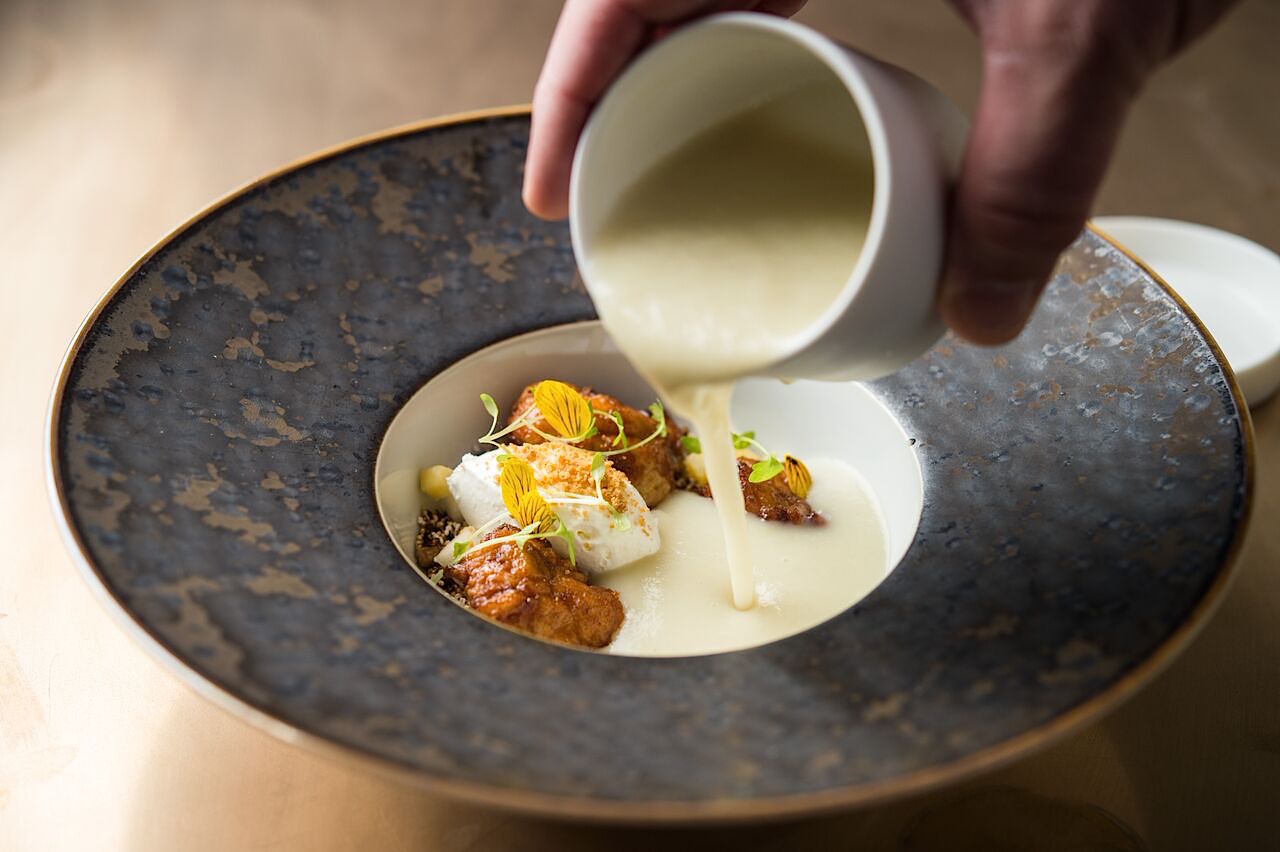 The appetizers
are among the most interesting I’ve seen in a
while. Pork belly is braised with baby spinach
(all the way from New Zealand, for some reason),
pickled mushrooms and a citrusy tom yum
broth to cut the meat’s fattiness. Raw
Nantucket bay scallops made a rare appearance this
season with bergamot grapefruit, hot yuzu kosho
aïoli and Japanese ash salt, each element with
just enough flavor to buoy the delicacy of the
scallops. Hudson Valley foie
gras ($29) was cooked perfectly, not mushy inside
but resilient to the touch of a fork, with a
Sauternes gelée, almonds, huckleberry, buckwheat
and carob molasses, which added up to too much
sweetness.
The appetizers
are among the most interesting I’ve seen in a
while. Pork belly is braised with baby spinach
(all the way from New Zealand, for some reason),
pickled mushrooms and a citrusy tom yum
broth to cut the meat’s fattiness. Raw
Nantucket bay scallops made a rare appearance this
season with bergamot grapefruit, hot yuzu kosho
aïoli and Japanese ash salt, each element with
just enough flavor to buoy the delicacy of the
scallops. Hudson Valley foie
gras ($29) was cooked perfectly, not mushy inside
but resilient to the touch of a fork, with a
Sauternes gelée, almonds, huckleberry, buckwheat
and carob molasses, which added up to too much
sweetness.
Wild
mushrooms were pleasingly roasted for a salad with
white sturgeon caviar (from a small producer in
Austria), bok choy and Napa cabbage emulsion.
Dungeness crab, black sea bass and bouchot mussels
came with a classic, ruddy bouillabaisse sauce
($46). Very light, fluffy sheep’s milk ricotta gnocchi took
on the flavors of spicy tomato and fennel, with a
sauce of octopus and Calabrian pepper made in the
style of a Bolognese ($24), with the octopus
working as the protein in the sauce.
In restaurants of Chevalier’s
caliber appetizers often outshine the main
courses, but every one of the entrees I tasted was
at the same high standard with what preceded them.
Lobster was gently poached in fine butter and came
with braised artichokes, ricotta gnudi
pasta and a reduction of lobster jus
($42). Gallante suggested a thick veal loin
be cooked medium-rare, which I agreed with, though
that night it was far closer to very rare, which
is not ideal for veal, but there were woodsy
enhancements like aligot,
in which parsnips replace potato pureed and folded
into Raclette cheese, with charred shallots and
chanterelles ($36).
I had no such
reservations about the rareness of superb Colorado
rack and loin of lamb with Cantellucio
lentils, sweet baby carrots and braised lamb belly
($44), which is as sumptuous a dish for a long
winter’s night as you’ll find in town. Both
roasted Brussels sprouts with bacon and potatoes gratin
dauphinois ($12 each) were impossible to
resist ordering. 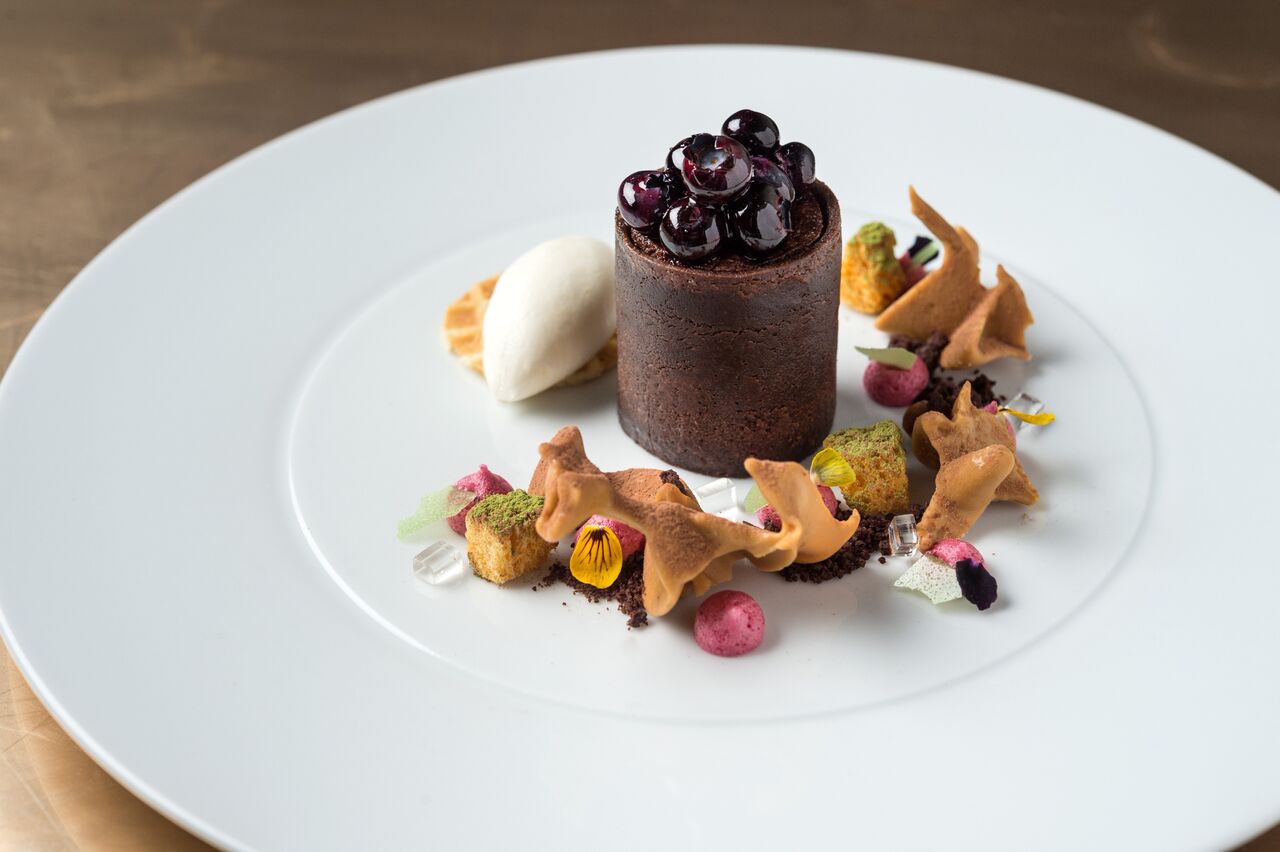
Chevalier has acquired one of
NYC’s most respected patîssiers in David
Carmichael, formerly at Gilt and Oceana, and his
creativity is at its height here. His
beignets ($16) are filled with crab apple
marmalade, rolled in cinnamon sugar, a ‘liquid’
pie crust—pastry blended with a simple syrup and
tempered with white chocolate to make it into a
spreadable form; it is then lavished with crème
Chantilly and apple sorbet, a sweet
masterpiece. And even if it went over the
top in richness ($16), the sticky toffee of date
pudding cake, dulce
crèmeaux, banana gelato and almond tuille
was fantastic.
Wine Director Jeff Taylor,
formerly at Betony and awarded “Sommelier of the
Year 2014” by Wine &
Spirits, stocks a wine cellar with an
appropriate number of labels—700—for a restaurant
of Chevalier’s refinement. The whole team here is
among the cream of the crop.
As I’ve had reason to
mention more than once, the NYC food media seem to
delight in insisting that people no longer want to
dine at Chevalier’s level of sophistication, but
the continued entry of new restaurants like
Gabriel Kreuther, Vaucluse, La Chine, Bâtard,
Betony, Juni and others belies such ignorant
pronouncements.
At least in NYC.
But that’s why NYC is
NYC.
❖❖❖
 WHAT I'M
DRINKING NOW
WHAT I'M
DRINKING NOWBy John Mariani
Joseph Drouhin
Vaudon Vaudesir Chablis Grand Cru ($55-$60)— The name "Moulin de Vaudon" comes
from the watermill nearby the property, whose
limestone-rich Chablis vineyards were abandoned after
the phylloxera infestation of the 19th
century. But Drouhin has restored them to Grand
Cru status, using biodynamic farming methods. I’ve
come to feel you really have to get to Grand Cru
level to appreciate the charms of Chablis—so much
boring Chablis is made in Burgundy—and yields are
kept low. This
example has richness while at the same time the
flinty, lean backbone that makes Chablis so
appealing with shellfish.
The name "Moulin de Vaudon" comes
from the watermill nearby the property, whose
limestone-rich Chablis vineyards were abandoned after
the phylloxera infestation of the 19th
century. But Drouhin has restored them to Grand
Cru status, using biodynamic farming methods. I’ve
come to feel you really have to get to Grand Cru
level to appreciate the charms of Chablis—so much
boring Chablis is made in Burgundy—and yields are
kept low. This
example has richness while at the same time the
flinty, lean backbone that makes Chablis so
appealing with shellfish.
Le Volte
dell’Ornellaia
2013
($30-$32)—An
IGT wine of Tuscany, this is the lesser label of
the great Ornellaia estate but shares much of the
DNA in a blend of 50% Merlot,
30% Sangiovese, and 20% Cabernet Sauvignon. The
vintage started with shaky weather but a good warm
summer followed that ultimately pushed the fruit
to ripen well over an entire month in autumn.
The
wine was aged for 10 months, partly in barrels
used for Ornellaia and partly in cement tanks, so
that the fruit was maintained and tannin muted. It does
not reach the heights of its illustrious big
sister but neither does its price, and I would
happily drink this any night of the week with
roasted meats or risotto with wild mushrooms.
 Donnachiara
Irpinia Coda di Volpe 2013
($9-$15)—This estate is in Montefalcone in
Campania, so there’s plenty of sun and volcanic
soil from Mount Vesuvius to
produce a good structure from the Coda di Volpe
(tail of the wolf) white varietal, whose virtues
are its balance of fruit and acidity, making it a
very good choice for shellfish in particular, of a
kind you’ll find in the restaurants of Naples and
the Amalfi Coast.
Donnachiara
Irpinia Coda di Volpe 2013
($9-$15)—This estate is in Montefalcone in
Campania, so there’s plenty of sun and volcanic
soil from Mount Vesuvius to
produce a good structure from the Coda di Volpe
(tail of the wolf) white varietal, whose virtues
are its balance of fruit and acidity, making it a
very good choice for shellfish in particular, of a
kind you’ll find in the restaurants of Naples and
the Amalfi Coast.
Matanzas
Creek Winery Merlot 2012
($28)—Ever experimenting but never experimental
for the sake of effect, Matanzas Creek always
looks at the Sonoma vineyards producing the best
grapes and the best clones of those grapes to
bring elegance to their wines. Following
a near perfect 2012 summer and after several
evaluations over a 14-month period, a blend (including just 2.3% Cabernet Sauvignon for
tannin) was made and returned to oak for two more
months so that the components could rest together. It is a
soft and satiny wine just skirting being too high
in alcohol, at 14.5%
(including just 2.3% Cabernet Sauvignon for
tannin) was made and returned to oak for two more
months so that the components could rest together. It is a
soft and satiny wine just skirting being too high
in alcohol, at 14.5%
Presqui’le
Vineyards Santa Maria Valley Pinot Noir 2013 ($60)—Presqui’le’s
President Matt Murphy and winemaker Dieter Cronje
show that California can make a solid, delicious
Pinot Noir without burning alcohol levels—the 2013
bottling comes in at 13.1%--from this 200-acre
winery founded in 2007. The vineyards enjoy the cool
Central Coast appellation, and all the family’s
wines are made in small batches, carefully tended
so that none takes on that cloying flavor that is
the major flaw of so many made-by-the-book Pinot
Noirs that seem
products of marketing than of good wine
making.
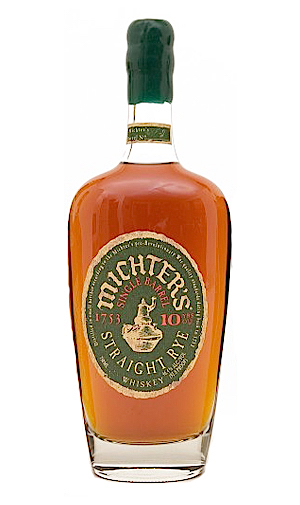 Michter’s 10 Year Rye
($150)—Along with drinking good wines, I like a
nightcap of Scotch, Irish or Bourbon, but I must
say I’ve been impressed by the recent flurry of
releases based on rye, which almost
Michter’s 10 Year Rye
($150)—Along with drinking good wines, I like a
nightcap of Scotch, Irish or Bourbon, but I must
say I’ve been impressed by the recent flurry of
releases based on rye, which almost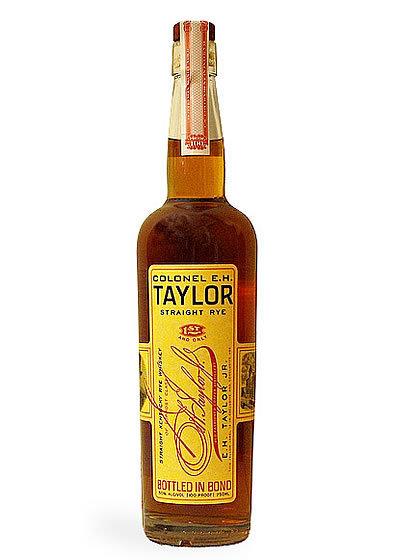 disappeared from the market in the ‘90s. Leading
the comeback is Michter’s (which had gone bankrupt
in 1989), whose Master Distiller Willie Pratt is
bringing back next month. I got
an advance tasting, and the maturity of the
whiskey is essential to appreciate the delicate
and not-so-delicate difference between rye and
corn-based bourbon.
It has an edge and a fine dryness (93
proof) that make you forget all that cheap
Canadian rye of the last century. . . . Colonel
E.H. Taylor, Jr. Straight Rye ($70) is less than
half the price of Michter’s and is a Bottled in
Bond blend
of rye and malted barley, so, while light in
color, at 100 proof, it has an engaging briary cut
to it and a slight sweetness that may remind you
of a single malt Scotch with American breeding. .
. . Acvording to spirits expert Fred Minnick, the
main reason rye is having a renaissance is that
"in 2000 Seagram folded their whiskey
operations and sold its Lawrenceburg, Indiana, distillery
to Pernod Ricard, which announced it would
close it in 2006. (CL Financial purchased it but
sold it five years later.)
disappeared from the market in the ‘90s. Leading
the comeback is Michter’s (which had gone bankrupt
in 1989), whose Master Distiller Willie Pratt is
bringing back next month. I got
an advance tasting, and the maturity of the
whiskey is essential to appreciate the delicate
and not-so-delicate difference between rye and
corn-based bourbon.
It has an edge and a fine dryness (93
proof) that make you forget all that cheap
Canadian rye of the last century. . . . Colonel
E.H. Taylor, Jr. Straight Rye ($70) is less than
half the price of Michter’s and is a Bottled in
Bond blend
of rye and malted barley, so, while light in
color, at 100 proof, it has an engaging briary cut
to it and a slight sweetness that may remind you
of a single malt Scotch with American breeding. .
. . Acvording to spirits expert Fred Minnick, the
main reason rye is having a renaissance is that
"in 2000 Seagram folded their whiskey
operations and sold its Lawrenceburg, Indiana, distillery
to Pernod Ricard, which announced it would
close it in 2006. (CL Financial purchased it but
sold it five years later.) 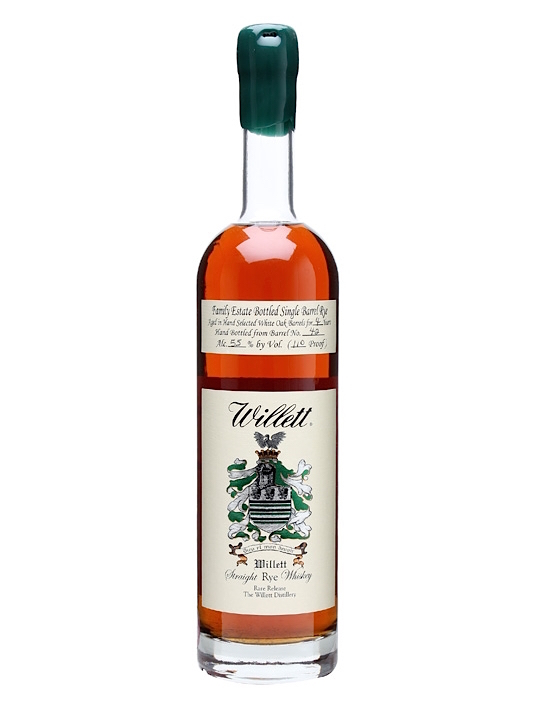 But the
distillery The distillery had a couple thousand
barrels of rye whiskey leftover with nowhere to go
so small brands started popping up,
buying the Indiana juice." Willett 4 Year Old
Single Barrel Rare Release ($45), at a
whopping 110° proof rye, is an Indiana rye.
Though the company opened its distillery
in 1937 and took until 2012 to produce their first
blended whiskey . This rye, which actually has
some corn in the mash, is a very smooth
whiskey indeed, with a pleasant burn, and faint
sweetnesshas a lush, sweet element to it.
But the
distillery The distillery had a couple thousand
barrels of rye whiskey leftover with nowhere to go
so small brands started popping up,
buying the Indiana juice." Willett 4 Year Old
Single Barrel Rare Release ($45), at a
whopping 110° proof rye, is an Indiana rye.
Though the company opened its distillery
in 1937 and took until 2012 to produce their first
blended whiskey . This rye, which actually has
some corn in the mash, is a very smooth
whiskey indeed, with a pleasant burn, and faint
sweetnesshas a lush, sweet element to it.
❖❖❖
IN HOSPITALS EITHER

Sen. Thom Tillis (R-NC)
has argued that restaurants should be able to “opt out”
of health department regulations requiring
employees wash their hands after using the restroom. “I
was having this discussion with someone," he said, "at a
Starbucks in my district, and we were talking about
certain regulations where I felt like maybe you should
allow businesses to opt out. . . as long as they
indicate through proper disclosure, through advertising,
through employment, literature, whatever else. . .
. I don’t have any problem with Starbucks if they
choose to opt out of this policy as long as the post a
sign that says ‘We don’t require our employees to wash
their hands after leaving the restrooms.’ The market
will take care of that. That’s probably one where every
business that did that would go out of business,
but I think it’s good to illustrate the point that
that’s the sort of mentality that we need to have to
reduce the regulatory burden on this country.”
 HMMMMMMM, WHAT
IF WILLIAM FAULKNER HAD DECIDED TO BECOME A
RESTAURANT CRITIC RATHER THAN WRITE THE SOUND AND THE FURY?
HMMMMMMM, WHAT
IF WILLIAM FAULKNER HAD DECIDED TO BECOME A
RESTAURANT CRITIC RATHER THAN WRITE THE SOUND AND THE FURY?
Any of John Mariani's books below may be ordered from amazon.com.
 I'm proud and happy to announce that my
new book, The Hound
in Heaven (21st Century Lion Books), has just
been published through Amazon and Kindle.
I'm proud and happy to announce that my
new book, The Hound
in Heaven (21st Century Lion Books), has just
been published through Amazon and Kindle. It is a novella, and for anyone who loves dogs, Christmas, romance, inspiration, even the supernatural, I hope you'll find this to be a treasured favorite. The story concerns how, after a New England teacher, his wife and their two daughters adopt a stray puppy found in their barn in northern Maine, their lives seem full of promise. But when tragedy strikes, their wonderful dog Lazarus and the spirit of Christmas are the only things that may bring back his master back from the edge of despair.
WATCH THE VIDEO!
“What a huge surprise turn this story took! I was completely stunned! I truly enjoyed this book and its message.” – Actress Ali MacGraw
“He had me at Page One. The amount of heart, human insight, soul searching, and deft literary strength that John Mariani pours into this airtight novella is vertigo-inducing. Perhaps ‘wow’ would be the best comment.” – James Dalessandro, author of Bohemian Heart and 1906.
“John Mariani’s Hound in Heaven starts with a well-painted portrayal of an American family, along with the requisite dog. A surprise event flips the action of the novel and captures us for a voyage leading to a hopeful and heart-warming message. A page turning, one sitting read, it’s the perfect antidote for the winter and promotion of holiday celebration.” – Ann Pearlman, author of The Christmas Cookie Club and A Gift for my Sister.
“John Mariani’s concise, achingly beautiful novella pulls a literary rabbit out of a hat – a mash-up of the cosmic and the intimate, the tragic and the heart-warming – a Christmas tale for all ages, and all faiths. Read it to your children, read it to yourself… but read it. Early and often. Highly recommended.” – Jay Bonansinga, New York Times bestselling author of Pinkerton’s War, The Sinking of The Eastland, and The Walking Dead: The Road To Woodbury.
“Amazing things happen when you open your heart to an animal. The Hound in Heaven delivers a powerful story of healing that is forged in the spiritual relationship between a man and his best friend. The book brings a message of hope that can enrich our images of family, love, and loss.” – Dr. Barbara Royal, author of The Royal Treatment.
 |
The Encyclopedia of American Food and Drink by John F. Mariani (Bloomsbury USA, $35) Modesty forbids me to praise my own new book, but let me proudly say that it is an extensive revision of the 4th edition that appeared more than a decade ago, before locavores, molecular cuisine, modernist cuisine, the Food Network and so much more, now included. Word origins have been completely updated, as have per capita consumption and production stats. Most important, for the first time since publication in the 1980s, the book includes more than 100 biographies of Americans who have changed the way we cook, eat and drink -- from Fannie Farmer and Julia Child to Robert Mondavi and Thomas Keller. "This book is amazing! It has entries for everything from `abalone' to `zwieback,' plus more than 500 recipes for classic American dishes and drinks."--Devra First, The Boston Globe. "Much needed in any kitchen library."--Bon Appetit. |
"Eating Italian will never be the same after reading John Mariani's entertaining and savory gastronomical history of the cuisine of Italy and how it won over appetites worldwide. . . . This book is such a tasteful narrative that it will literally make you hungry for Italian food and arouse your appetite for gastronomical history."--Don Oldenburg, USA Today. "Italian
restaurants--some good, some glitzy--far
outnumber their French rivals. Many of
these establishments are zestfully described
in How Italian Food Conquered the World, an
entertaining and fact-filled chronicle by
food-and-wine correspondent John F.
Mariani."--Aram Bakshian Jr., Wall Street
Journal.
"Equal parts
history, sociology, gastronomy, and just
plain fun, How Italian Food Conquered the
World tells the captivating and delicious
story of the (let's face it) everybody's
favorite cuisine with clarity, verve and
more than one surprise."--Colman Andrews,
editorial director of The Daily
Meal.com. "A fantastic and fascinating
read, covering everything from the influence
of Venice's spice trade to the impact of
Italian immigrants in America and the
evolution of alta cucina. This book will
serve as a terrific resource to anyone
interested in the real story of Italian
food."--Mary Ann Esposito, host of PBS-TV's
Ciao
Italia. "John Mariani has written the
definitive history of how Italians won their
way into our hearts, minds, and
stomachs. It's a story of pleasure over
pomp and taste over technique."--Danny Meyer,
owner of NYC restaurants Union Square
Cafe, The Modern, and Maialino.
|
 |
 |
 |
 |
 |
 |
 |
 |
 Everett Potter's Travel Report:
Everett Potter's Travel Report: 
 Eating Las
Vegas JOHN CURTAS has been covering
the Las Vegas food and restaurant scene
since 1995. He is the co-author of EATING LAS
VEGAS – The 50 Essential Restaurants (the
fourth edition of which will be published in
early 2016), as well as the author of the Eating Las
Vegas web site: www.eatinglasvegas.
He can also be seen every Friday morning as
the “resident foodie” for Wake Up With the
Wagners on KSNV TV (NBC) Channel 3 in
Las Vegas.
Eating Las
Vegas JOHN CURTAS has been covering
the Las Vegas food and restaurant scene
since 1995. He is the co-author of EATING LAS
VEGAS – The 50 Essential Restaurants (the
fourth edition of which will be published in
early 2016), as well as the author of the Eating Las
Vegas web site: www.eatinglasvegas.
He can also be seen every Friday morning as
the “resident foodie” for Wake Up With the
Wagners on KSNV TV (NBC) Channel 3 in
Las Vegas.

MARIANI'S VIRTUAL GOURMET
NEWSLETTER is published weekly. Editor/Publisher: John
Mariani.
Editor: Walter Bagley. Contributing Writers: Christopher Mariani,
Robert Mariani, Misha
Mariani,
John A. Curtas, Edward Brivio, Mort Hochstein,
Andrew Chalk, Dotty Griffith and Brian Freedman. Contributing
Photographers: Galina Dargery, Bobby
Pirillo. Technical Advisor: Gerry McLoughlin.
To un-subscribe from this newsletter,click here.
© copyright John Mariani 2016

